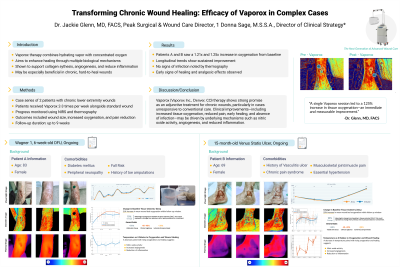Case Series/Study
(CS-053) Transforming Chronic Wound Healing: Efficacy of Vaporous Hyperoxia Therapy in Complex Cases
Friday, May 2, 2025
7:45 PM - 8:45 PM East Coast USA Time

Donna Sage, M.S.S.A – Director of Clinical Strategy, Vaporox Inc.
Introduction: Vaporous Hyperoxia Therapy (VHT) represents a promising approach for the management of chronic wounds, particularly in cases such as diabetic foot ulcers, pressure ulcers, and venous insufficiency ulcers. This innovative treatment modality combines hydrating vapor with concentrated oxygen, which is believed to enhance wound healing through several biological mechanisms. Research indicates that hyperoxia can stimulate angiogenesis and promote collagen synthesis, both of which are critical for effective tissue repair and regeneration (Abedi et al. 2024; Crowley et al. 2017; Kawada, Ohtani, and Ishii 2010). Furthermore, hyperoxia has been shown to modulate inflammatory responses, thereby potentially reducing the chronic inflammation often associated with non-healing wounds (Abedi et al. 2024; Hatfield et al. 2015).
Methods: In a case-series study involving four patients with chronic lower extremity wounds, VHT* was integrated into a multimodal treatment protocol that included standard wound care. Patients received 2-3 VHT sessions weekly, and their progress was monitored using advanced imaging techniques such as Near-Infrared Spectroscopy (NIRS) and thermography imaging**. Clinical outcomes, such as wound size reduction and pain alleviation, were tracked, with follow-up durations extending up to 9 weeks.
Results: The results demonstrated significant clinical improvements, with all patients showing increased tissue oxygenation after each VHT session and a clear longitudinal trend, suggesting enhanced blood flow and angiogenesis. No signs of infection were detected via thermography. In one case, a patient with wounds on both the medial and lateral posterior legs was showing early signs of healing. Although new wounds developed, the initial site demonstrated notable healing progress.
Discussion: The findings from this case-series study underscore the potential of VHT as an adjunctive therapy in chronic wound management. The therapy not only addresses immediate concerns such as wound size reduction and pain alleviation but also facilitates long-term wound management by promoting a favorable healing environment. The use of NIRS and thermography for monitoring therapeutic effects allows for personalized care adjustments, enhancing the overall effectiveness of the treatment protocol. These results advocate for the broader integration of VHT into clinical practices, particularly for complex wounds that are resistant to conventional therapies.
Methods: In a case-series study involving four patients with chronic lower extremity wounds, VHT* was integrated into a multimodal treatment protocol that included standard wound care. Patients received 2-3 VHT sessions weekly, and their progress was monitored using advanced imaging techniques such as Near-Infrared Spectroscopy (NIRS) and thermography imaging**. Clinical outcomes, such as wound size reduction and pain alleviation, were tracked, with follow-up durations extending up to 9 weeks.
Results: The results demonstrated significant clinical improvements, with all patients showing increased tissue oxygenation after each VHT session and a clear longitudinal trend, suggesting enhanced blood flow and angiogenesis. No signs of infection were detected via thermography. In one case, a patient with wounds on both the medial and lateral posterior legs was showing early signs of healing. Although new wounds developed, the initial site demonstrated notable healing progress.
Discussion: The findings from this case-series study underscore the potential of VHT as an adjunctive therapy in chronic wound management. The therapy not only addresses immediate concerns such as wound size reduction and pain alleviation but also facilitates long-term wound management by promoting a favorable healing environment. The use of NIRS and thermography for monitoring therapeutic effects allows for personalized care adjustments, enhancing the overall effectiveness of the treatment protocol. These results advocate for the broader integration of VHT into clinical practices, particularly for complex wounds that are resistant to conventional therapies.

.jpg)